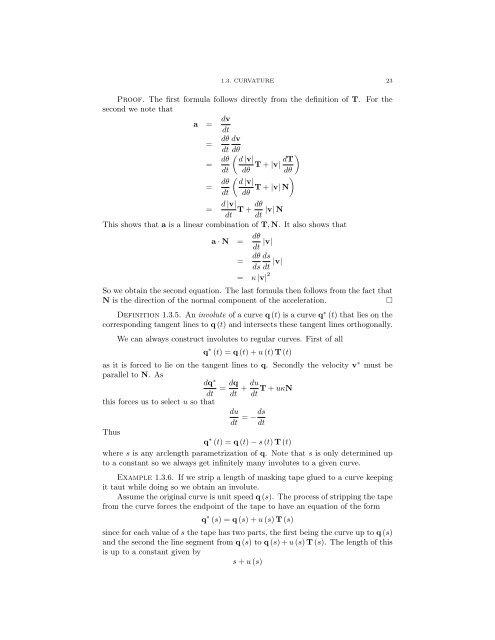Lecture Notes for 120 - UCLA Department of Mathematics
Lecture Notes for 120 - UCLA Department of Mathematics
Lecture Notes for 120 - UCLA Department of Mathematics
You also want an ePaper? Increase the reach of your titles
YUMPU automatically turns print PDFs into web optimized ePapers that Google loves.
1.3. CURVATURE 23<br />
Pro<strong>of</strong>. The first <strong>for</strong>mula follows directly from the definition <strong>of</strong> T. For the<br />
second we note that<br />
a = dv<br />
dt<br />
= d✓ dv<br />
dt d✓<br />
= d✓<br />
dt<br />
= d✓<br />
dt<br />
✓ d |v|<br />
◆<br />
dT<br />
T + |v|<br />
d✓<br />
d✓<br />
✓ ◆<br />
d |v|<br />
d✓ T + |v| N<br />
= d |v|<br />
dt T + d✓<br />
dt |v| N<br />
This shows that a is a linear combination <strong>of</strong> T, N. It also shows that<br />
a · N = d✓<br />
dt |v|<br />
= d✓ ds<br />
ds dt |v|<br />
= apple |v| 2<br />
So we obtain the second equation. The last <strong>for</strong>mula then follows from the fact that<br />
N is the direction <strong>of</strong> the normal component <strong>of</strong> the acceleration.<br />
⇤<br />
Definition 1.3.5. An involute <strong>of</strong> a curve q (t) is a curve q ⇤ (t) that lies on the<br />
corresponding tangent lines to q (t) and intersects these tangent lines orthogonally.<br />
We can always construct involutes to regular curves. First <strong>of</strong> all<br />
q ⇤ (t) =q (t)+u (t) T (t)<br />
as it is <strong>for</strong>ced to lie on the tangent lines to q. Secondly the velocity v ⇤ must be<br />
parallel to N. As<br />
dq ⇤<br />
= dq<br />
dt dt + du<br />
dt T + uappleN<br />
this <strong>for</strong>ces us to select u so that<br />
du<br />
dt =<br />
Thus<br />
q ⇤ (t) =q (t) s (t) T (t)<br />
where s is any arclength parametrization <strong>of</strong> q. Note that s is only determined up<br />
to a constant so we always get infinitely many involutes to a given curve.<br />
Example 1.3.6. If we strip a length <strong>of</strong> masking tape glued to a curve keeping<br />
it taut while doing so we obtain an involute.<br />
Assume the original curve is unit speed q (s). The process <strong>of</strong> stripping the tape<br />
from the curve <strong>for</strong>ces the endpoint <strong>of</strong> the tape to have an equation <strong>of</strong> the <strong>for</strong>m<br />
ds<br />
dt<br />
q ⇤ (s) =q (s)+u (s) T (s)<br />
since <strong>for</strong> each value <strong>of</strong> s the tape has two parts, the first being the curve up to q (s)<br />
and the second the line segment from q (s) to q (s)+u (s) T (s). The length <strong>of</strong> this<br />
is up to a constant given by<br />
s + u (s)
















